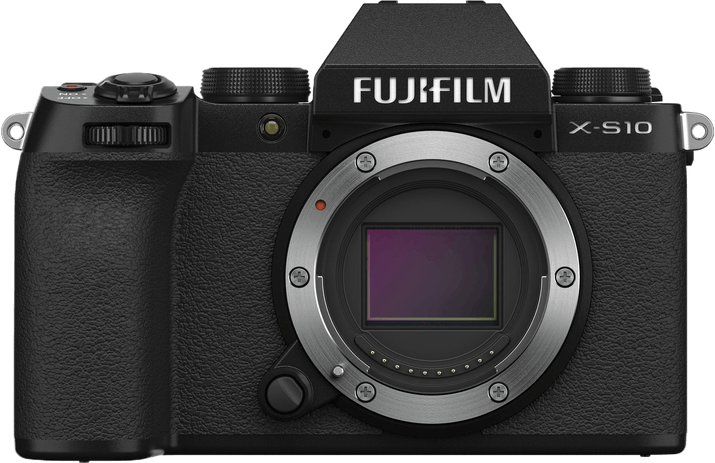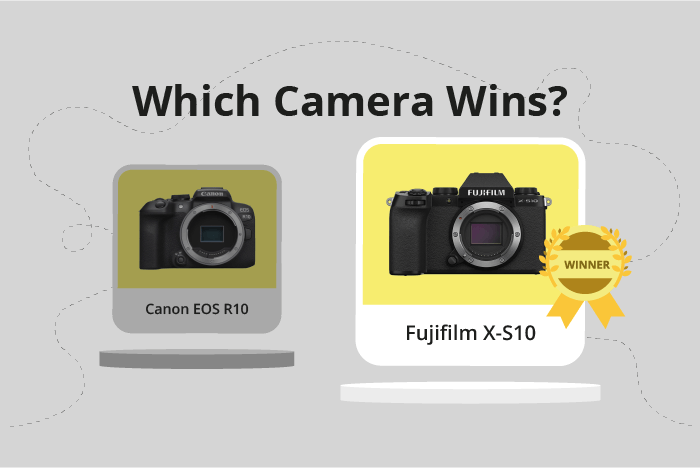Canon EOS R10 vs Fujifilm X-S10 Comparison
Canon EOS R10

Fujifilm X-S10

The Canon EOS R10 and Fujifilm X-S10 both receive a score of 69/100, indicating a close competition between these mirrorless cameras. They share similarities in launch price, with the EOS R10 at $980 and the X-S10 at $999. Both cameras were released in recent years, with the EOS R10 being newer (2022) compared to the X-S10 (2020).
The Canon EOS R10 outperforms the Fujifilm X-S10 in terms of size and weight. It measures 123 x 88 x 83mm and weighs 426g (0.94lbs), making it more compact and lightweight than the X-S10, which measures 126 x 85 x 65mm and weighs 465g (1.03lbs).
However, the Fujifilm X-S10 has the advantage of being an older model, which may lead to more affordable prices on the market today. Considering all factors, both cameras offer strong features, with the EOS R10 excelling in portability and the X-S10 potentially providing better value for money.
Canon EOS R10 vs Fujifilm X-S10 Overview and Optics
The Fujifilm X-S10 narrowly outshines the Canon EOS R10 in terms of optics, with a score of 72/100 versus the Canon’s 71/100. Both cameras share several key specifications, including an APS-C CMOS sensor, which provides excellent image quality. They also have proprietary processors, with the Canon utilizing a Digic X and the Fujifilm using an X-Processor 4, ensuring fast and efficient performance.
The Fujifilm X-S10 holds an advantage in megapixels, boasting 26 compared to the Canon EOS R10’s 24. This difference allows the Fujifilm to capture more detail in images. Furthermore, the X-S10 has a faster shooting speed of 20 frames per second (fps) compared to the R10’s 15 fps, making it better suited for action photography.
However, the Canon EOS R10 has a notable edge when it comes to sensor performance, as evidenced by its DXOMARK score of 97. Unfortunately, DXOMARK does not score Fujifilm cameras, so a direct comparison is not possible. Additionally, the Canon R10 features a Canon RF lens mount, which offers compatibility with a wide range of high-quality lenses.
One crucial advantage the Fujifilm X-S10 has over the Canon EOS R10 is its built-in image stabilization. This feature helps reduce camera shake and improve image sharpness, particularly in low light conditions or when using longer focal lengths.
Taking these factors into account, the Fujifilm X-S10 is the superior choice for photographers in need of greater detail and faster shooting speeds, as well as image stabilization. On the other hand, the Canon EOS R10 may be more suitable for those prioritizing sensor performance and access to the Canon RF lens ecosystem.
Canon EOS R10 vs Fujifilm X-S10 Video Performance
The Canon EOS R10 and the Fujifilm X-S10 both score 91/100 in video capabilities, making it a tie between the two cameras. They share common specifications, such as 4K max video resolution and built-in time-lapse functionality. However, there are differences in their video capabilities that may influence a buyer’s decision.
The Canon EOS R10 has a max video dimension of 3840 x 2160 and a max video frame rate of 120fps. These specifications allow for high-quality video recording and smooth playback. The R10’s video capabilities are suitable for professional use, as well as for enthusiasts who want to capture stunning footage.
On the other hand, the Fujifilm X-S10 surpasses the EOS R10 in both max video dimensions and max video frame rate. The X-S10 offers 4096 x 2160 video dimensions and a remarkable 240fps max video frame rate. This means that the X-S10 can record even more detailed video and offers the ability to capture slow-motion footage at double the frame rate of the EOS R10.
While both cameras have impressive video capabilities, the Fujifilm X-S10 has an edge in terms of max video dimensions and frame rate. This advantage may appeal to videographers who prioritize higher resolution and slow-motion capture. However, the Canon EOS R10 remains a strong contender for those who are satisfied with its video specifications.
Ultimately, the choice between the Canon EOS R10 and the Fujifilm X-S10 depends on individual preferences and priorities regarding video quality, resolution, and frame rate. Both cameras are excellent options, and their tied score of 91/100 reflects their strong video capabilities.
Canon EOS R10 vs Fujifilm X-S10 Features and Benefits
The Canon EOS R10 and the Fujifilm X-S10 both receive a feature score of 70/100, indicating that they have similar capabilities in terms of additional features. Both cameras share several specifications, such as screen size, screen resolution, touchscreen capability, flip screen, GPS absence, and Bluetooth connectivity.
The Canon EOS R10 outperforms the Fujifilm X-S10 in terms of WIFI connectivity, which the X-S10 lacks. This feature is useful for photographers who need to transfer images quickly and easily to other devices or share them online. The presence of WIFI in the EOS R10 provides a significant advantage for those who prioritize seamless connectivity in their camera choice.
On the other hand, the Fujifilm X-S10 does not offer any distinct advantages over the Canon EOS R10 in terms of features, as both cameras share the same score and most specifications. The only difference between the two is the absence of WIFI in the X-S10, which puts it at a disadvantage compared to the EOS R10.
Based on the comparison of features, the Canon EOS R10 is the better choice for photographers who value convenient connectivity and sharing options. The WIFI capability sets it apart from the Fujifilm X-S10, making it a more versatile camera in terms of features. The Fujifilm X-S10, while not offering any unique advantages, remains a solid choice for those who do not require WIFI and prioritize other aspects of the camera’s performance.
Canon EOS R10 vs Fujifilm X-S10 Storage and Battery
The Canon EOS R10 outperforms the Fujifilm X-S10 in storage and battery with a score of 40/100 compared to 35/100. Both cameras have one memory card slot and accept SD, SDHC, and SDXC cards with UHS-I compatibility. They also both support USB charging, making them convenient for on-the-go use.
The EOS R10 has a superior battery life, offering 450 shots per charge, while the X-S10 provides only 325 shots. This difference allows the Canon camera to capture more images before needing a battery replacement or recharge. The R10 uses an LP-E17 battery type, which contributes to its extended battery life.
On the other hand, the Fujifilm X-S10 uses an NP-126S battery type, which results in a shorter battery life. While the X-S10 lags behind the R10 in this aspect, it still provides a decent number of shots for casual photography sessions.
Considering the storage and battery aspects, the Canon EOS R10 proves to be a better choice for photographers seeking longer shooting sessions without interruption. The Fujifilm X-S10, while not as strong in this area, remains a viable option for less demanding photography needs.
Canon EOS R10 vs Fujifilm X-S10 – Our Verdict
Are you still undecided about which camera is right for you? Have a look at these popular comparisons that feature the Canon EOS R10 or the Fujifilm X-S10:

